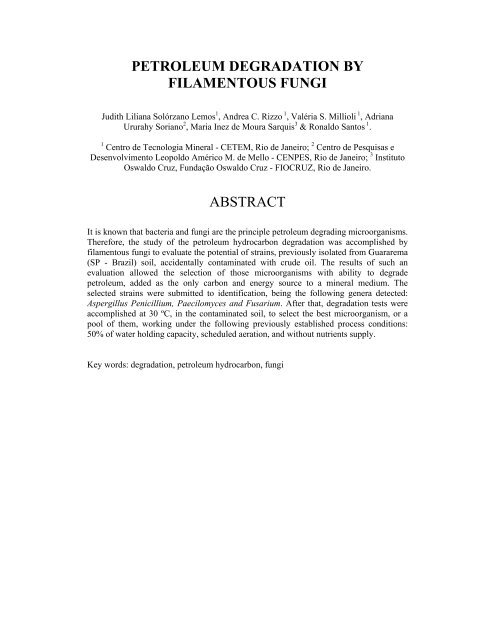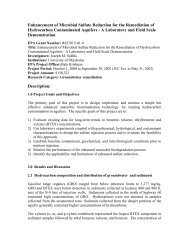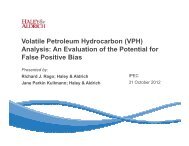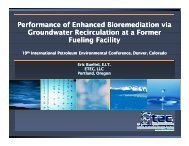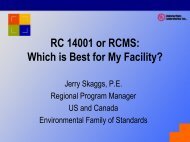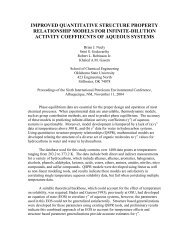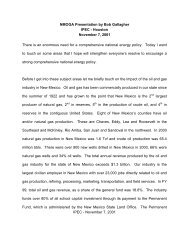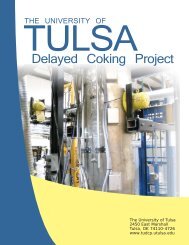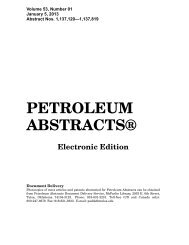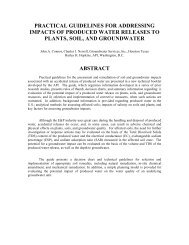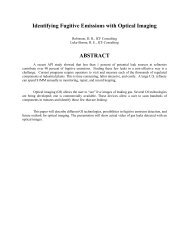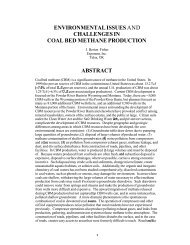PETROLEUM DEGRADATION BY FILAMENTOUS FUNGI - IPEC
PETROLEUM DEGRADATION BY FILAMENTOUS FUNGI - IPEC
PETROLEUM DEGRADATION BY FILAMENTOUS FUNGI - IPEC
Create successful ePaper yourself
Turn your PDF publications into a flip-book with our unique Google optimized e-Paper software.
<strong>PETROLEUM</strong> <strong>DEGRADATION</strong> <strong>BY</strong><strong>FILAMENTOUS</strong> <strong>FUNGI</strong>Judith Liliana Solórzano Lemos 1 , Andrea C. Rizzo 1 , Valéria S. Millioli 1 , AdrianaUrurahy Soriano 2 , Maria Inez de Moura Sarquis 3 & Ronaldo Santos 1 .1 Centro de Tecnologia Mineral - CETEM, Rio de Janeiro; 2 Centro de Pesquisas eDesenvolvimento Leopoldo Américo M. de Mello - CENPES, Rio de Janeiro; 3 InstitutoOswaldo Cruz, Fundação Oswaldo Cruz - FIOCRUZ, Rio de Janeiro.ABSTRACTIt is known that bacteria and fungi are the principle petroleum degrading microorganisms.Therefore, the study of the petroleum hydrocarbon degradation was accomplished byfilamentous fungi to evaluate the potential of strains, previously isolated from Guararema(SP - Brazil) soil, accidentally contaminated with crude oil. The results of such anevaluation allowed the selection of those microorganisms with ability to degradepetroleum, added as the only carbon and energy source to a mineral medium. Theselected strains were submitted to identification, being the following genera detected:Aspergillus Penicillium, Paecilomyces and Fusarium. After that, degradation tests wereaccomplished at 30 ºC, in the contaminated soil, to select the best microorganism, or apool of them, working under the following previously established process conditions:50% of water holding capacity, scheduled aeration, and without nutrients supply.Key words: degradation, petroleum hydrocarbon, fungi
INTRODUCTIONThe petroleum industry is responsible for the generation of high amounts oforganic residues, as well as for the pollution of soils, rivers and seas. The potentiality ofthe microorganisms, pointed out in literature as agents of degradation of severalcompounds, indicates biological treatments as the most promising alternative to reducethe environmental impact caused by oil spills.It is known that the main microorganisms consuming petroleum hydrocarbons arebacterias and fungi. However, the filamentous fungi possess some attributes that enablethem as good potential agents of degradation, once those microorganisms ramifiesquickly on the substratum, digesting it through the secretion of extracellular enzymes.Besides, the fungi are capable to grow under environmental conditions of stress, forexample: environment with low pH values or poor in nutrients and with low wateractivity. Several authors have made lists containing bacteria and fungi genera that areable to degrade a wide spectrum of pollutants, proceeding from marine atmosphere aswell as the soil (1, 2, 3). In accordance with several scientific publications, can be pointedout that, amongst the filamentous fungi Trichoderma and Mortierella spp are the mostcommon ones isolated from the soil. Aspergillus and Penicillium spp have frequentlybeen isolated from marine and terrestrial environments. In this way, microbiology ofhydrocarbons degradation constitutes a field of research under development, oncemicrobiological procedures may be used in the decontamination processes (4).Therefore, the objective of the present work was to identify microorganismscapable to degrade petroleum hydrocarbons with views to a future employment in thebioremediation of polluted soils.SoilMATERIALS AND METHODSThe soil employed in this study was collected in Guararema, SP, Brazil and wascharacterized as a clayey-sand. It was accidentally contaminated in December of 1998due to a crude oil spill. Nonetheless, the soil samples used in the isolation andidentification of the fungi as well as in the biodegradation tests were collected in Octoberof 1999 and in October of 2001, respectively. An uncontaminated soil sample wascollected in a boundary area.Microorganisms IsolationMicrobial isolation was realized from two samples of Guararema polluted soil,through successive dilutions, and inoculation in Petri dishes, where 3 different mediawere used (Sabouraud, Potato Dextrose Agar -PDA- and Czapeck) with the purpose ofoffering different nutritional options for the development of several fungi species thatcould have been established in the samples, during the natural process of soil weathering.
Based on the accumulated value of CO 2 generated at the end of the experiments,and on the information that 50% of the total carbon consumed is normally incorporatedinto the biomass, the biodegradation efficiency could be calculated (EB) as follows:Mass of carbon totally degraded = 2 x Mass of generated CO 2EB% = (Mass of carbon totally degraded) X 100Mass of soil total organic matterOrganic matterAnalysis of organic matter were carried out through the ignition method usingmuffle at 1000 ºC by 1 hour, with the objective of corroborating the results obtained byevolution of CO 2 . Afterwards the samples were weighed after reaching room temperature.RESULTS AND DISCUSSIONSeveral microorganisms were obtained in the present work through media andconventional techniques of isolation as shown in Figure 1.Determination of hydrocarbons degradation capacity allowed the selection of thestrains that actually contributed in the degradation of the petroleum hydrocarbons,diminishing the number of strains guided for identification.The results of petroleum hydrocarbons degradation (Figure 2) along 7 days, inmineral, mineral with glucose and mineral with yeast extract (YE) media showed that themicrobial action was stimulated in the media that contained other sources of carbonbesides petroleum, accelerating, in that way, the degradation of the substratum in the 1 stday of cultivation. That fact was well observed in the medium containing YE, thatbesides supplying an extra carbon source for the strains, also offered nitrogen source,vitamins and mineral salts. In spite of that, after the 7 th day of cultivation, the degradationeffect of the microorganisms in mineral medium were similar to those cultivated in mediawith glucose and YE.A total of 9 different species were detected in Guararema soil and are presentedin Table 1. All of those strains have been reported as commonly isolated from soil byother authors (8, 9, 10).Biodegradation efficiencies of the studied conditions were calculated from CO 2accumulated values, and the results are presented in Figure 3. In agreement with those
esults, condition 5 presented the higher biodegradation efficiency (10.8%). Thispreliminary experiment allowed to point out Aspergillus versicolor as bearing the highestpotential to degrade petroleum hydrocarbons when compared to Aspergillus niger (7.3%)responsible for de second best result, in relation to the others fungi whose biodegradationefficiency were between 7.3% and 6.6%.Figure 4 represents the evolution of CO 2 obtained with the addition of A.versicolor to the polluted soil and monitored in a period of 41 days. A continuous andgrowing evolution of CO 2 was observed along the treatment, indicating the possibility ofobtaining highest biodegradation efficiencies in an extended period of time. On the otherhand, the absence of the lag phase in the degradation process evidences a previousadaptation of A. versicolor and the native microbes to the existent conditions in thepolluted soil, as well as to the ones established for the assay.Figure 5 shows the removal of organic matter results obtained through theanalysis of organic matter by ignition of the initial and final samples. This experimentdisplays the same tendency of that obtained through the chromatographic analysesshowing an accentuated decline in conditions 3 and 7. Besides, this experiment allowedto corroborate A. versicolor degrading potential through the largest removal of organicmatter (11.37%), strengthening the previous results.CONCLUSIONIn conclusion the results showed that representatives of the filamentous fungicorresponded to 4 genera and 9 species, being the species as follows: Aspergillus niveus,Aspergillus niger, Aspergillus versicolor, Aspergillus terreus, Aspergillus fumigatus,Penicillium corylophilum, Parcilomyces variotti, Paecilomyces niveus and Fusarium sp.A. versicolor presented the highest biodegradation efficiency (10.8%) as well as theorganic matter removal (11.4%), and may be pointed out as a potential fungus to degradepetroleum hydrocarbons, especially those spilled out over Guararema soil.REFERENCES1. Bouchez, M., Blanchet, D., Haeseler, F. and Vandecasteele, J. P. “Les hydrocarburesaromatiques polycycliques dans l’environnement”, Revue de l’Institut français dupétrole, 51, 797-828 (1996).2. Yateem, A., Balba, M.T. and Al-Awadhi, N. "White rot fungi and their role inremediating oil-contaminated soil". Environment International, 24, 181-187 (1998).3. Juhasz, A.L. and Naidu, R. "Bioremediation of high molecular weight polycyclicaromatic hydrocarbons: a review of the microbial degradation of benzo[a]pyrene".International Biodeterioration & Biodegradation. 45, 57- 88 (2000).
4. Bonaventura, C. and Johnson, F.M. "Healthy environments for healthy people:Bioremediation today and tomorrow". Environmental Health Perspectives, 105,5-20 (1997).5. Gerlach, W. and Nirenbergh, H. The genus Fusarium, a pictorial atlas, Berlin, Institutfür Mikrobiologie Press (1982).6. Nirenberg, H. I., Identification of Fusaria ocurring in Europe on cereals and potatos,In: Fusarium: Mycotoxins, Taxonomy and Pathogenicity, 170-193, Amsterdam, J.Chelkowski, Editor, Elsevier Science Publishers B. V. (1989).7. Rivalier, E. and Seydel, S. “Nouveau procedé de culture sur lames gélosées apliqué al’étude microscopique des champignos deteignes”, Annales de ParasitologieHumaine et Comparee, 10, 444-452 (1932).8. Oudot, J., Fusey, P., Abdelouahid, D.E. Haloui, S. and Roquebert, M.F. "Capacitésdégradatives de bactéries et de champignons isolés d'um sol contaminé par um fuel".Canadian Journal of Microbiology, 33, 232-243 (1987).9. Oudot, J., Dupont, J., Haloui, S. and Roquebert, M.F. "Biodegradation potential ofhydrocarbon-assimilating tropical fungi". Soil Biology and Biochemistry, 25, 1167-1173 (1993).10. Chaîneau, C.H., Morel, J., Dupont, J., Bury, E. and Oudot, J. "Comparison of thefuel oil biodegradation potential of hydrocarbon-assimilating microorganismsisolated from a temperate agricultural soil". The Science of the Total Environmental,227, 237-247.
Table 1. Identified strainsStrainsAspergillus terreusAspergillus fumigatusAspergillus versicolorAspergillus niveusAspergillus nigerPenicillium corylophilumPaecilomyces variottiPaecilomyces niveusFusarium spTable 2. Fungi and samples conditions in biodegradation testIdentificationSamples1 Uncontaminated soil2 Contaminated soil3 Contaminated soil + Aspergillus terreus4 Contaminated soil + Aspergillus fumigatus5 Contaminated soil + Aspergillus versicolor6 Contaminated soil + Aspergillus niveus7 Contaminated soil + Aspergillus niger8 Contaminated soil + Penicillium corylophilum9 Contaminated soil + Paecilomyces variotti10 Contaminated soil + Paecilomyces niveus11 Contaminated soil + Fusarium spSabouraudPDACzapeckFigure 1. Microbial growth in Petri dishes containing Sabouraud, PDA and Czapeck media.
Biodegradation Efficiency (%)1210864201 2 3 4 5 6 7 8 9 10 11TreatmentsFigure 3. Biodegradation efficiency of fungi65CO 2 (mmol)432100 10 20 30 40 50Time (days)Figure 4. Production of CO 2 by Aspergillus versicolor.


